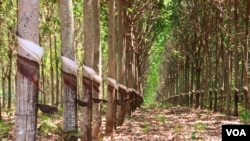Economic land concessions are having a huge impact on Cambodia’s northeastern forests, a new reports shows.
The report, “Logs and Patronage: Systematic Illegal Logging and the Destruction of State Forests and Protected Areas,” focuses on Virachey National Park and the provinces of Ratanakkiri and Stung Treng, where indigenous people have relied on forests for generations, but where luxury timber has proven lucrative for companies.
“Many companies have carried out logging in this area, surrounding and inside this park, including An Mady Group, Kith Meng Group, the tycoon Limm Bunna, Mong Rithy Company, Hoang Anh Gialai, Jaing Li Company and Men Sarun Co., Ltd.,” the report says. “The logging started in 2006 and was carried out on until 2013.”
The companies focused on luxury timber, including rosewood, which fetches up to $100,000 per cubic meter. The timber feeds demand from China, Laos and Vietnam, in particular. Since 2013, the companies have withdrawn and were replaced by Try Pheap Group, which has continued harvesting luxury timber, the report alleges.
Representatives of the companies named in the report were not immediately available for comment.
The report, undertaken by a group of civil society organizations, took months to research. In a seminar held by NGO Forum to discuss the report Wednesday, members of communities from the affected provinces expressed their concern.
Srun Darith, a senior official from the Ministry of Environment, said there are not enough rangers to protect the forest from illegal logging. “Do our forest rangers have enough capacity to control 10,000 hectares of forest?” he asked.
The report also shows that local communities play a role, working in illegal logging due to a lack of other jobs. One commune chief told VOA Khmer that illegal logging has become a race between companies and communities. “If we don’t cut, the company still cuts,” he said. “Logging for money is better than losing everything.”
Still, those who attended Wednesday’s seminar urged the government to do more to stop the practice. Based on calculations of the number of logging trucks counted leaving the area, an estimated 81,000 trees, or 243,000 cubic meters of timber, were taken out of the two provinces in 2014.








